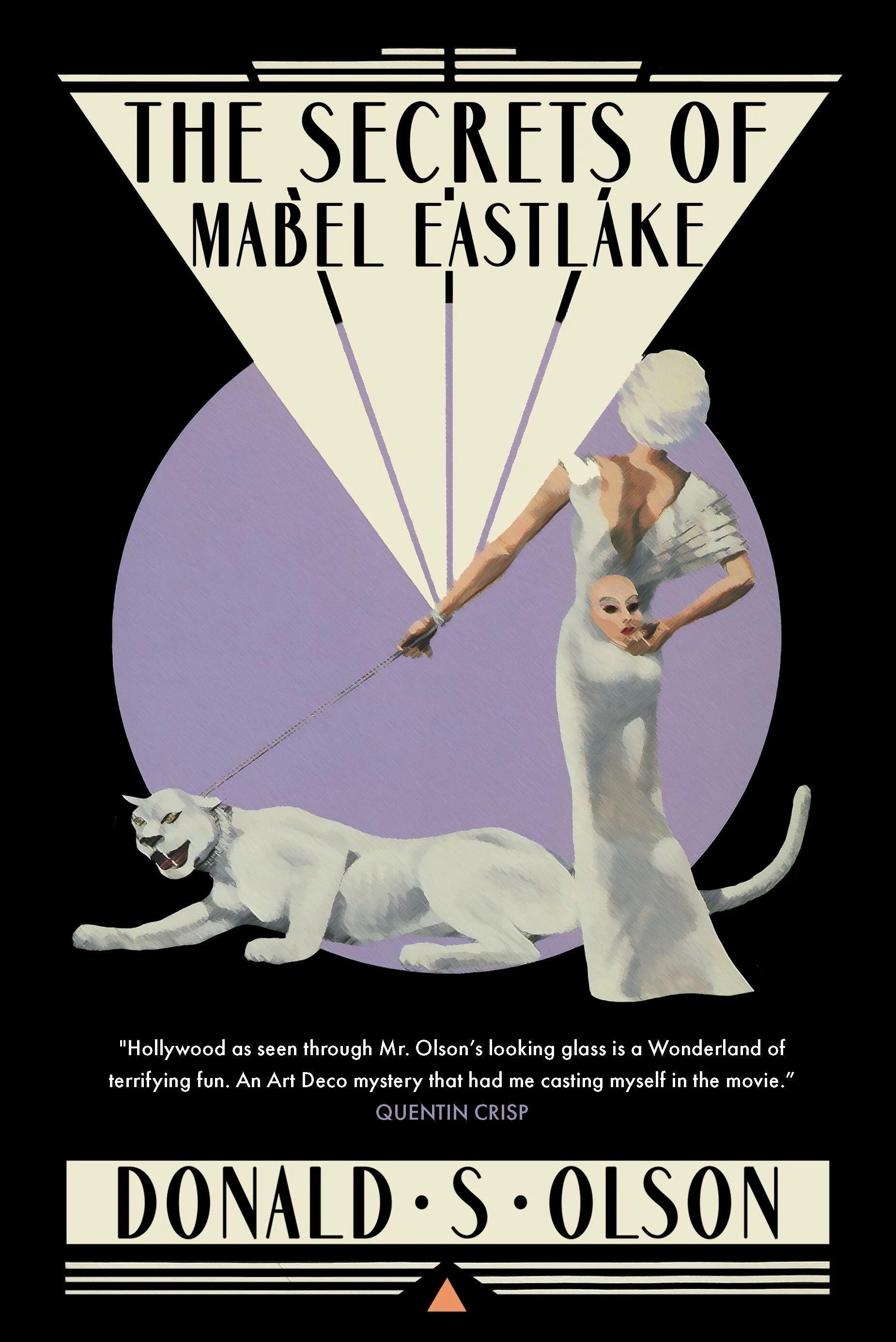The Secrets of Mabel Eastlake
NOW AVAILABLE IN A NEW eBOOK EDITION FROM LUME BOOKS
"Hollywood as seen through Mr. Olson’s looking glass is a Wonderland of terrifying fun. An Art Deco mystery that had me casting myself in the movie.” - (Quentin Crisp)
Press photo of the author taken at a reading of The Secrets of Mabel Eastlake in 1987
Author's Note
Where is my Mabel Eastlake file? Where is my paper trail? I can’t find it anywhere, and since The Secrets of Mabel Eastlake was published in 1986, long before the advent of the Internet, there’s nowhere I can go to look up the reviews and interviews. So I’ll have to tell you about Mabel in my own words.
Chapter 1
In 1980, Christopher Street, the nation’s only gay literary magazine, published a story of mine called “Anything Can Happen.” The story was noticed by Pat Loud, the matriarch of the PBS reality-TV series “An American Family.”Pat had left New York and was working as a literary agent in New York. She took me on as a client and asked if I could write something “scary and fun.” I had completed two “literary” (translation: “serious”) novels by then, but neither had found a publisher, and I was frankly in need of money. While researching movies made in the 1930s I’d come across an old Hollywood legend about one of the era’s most famous female sex goddesses, and I thought it might make a good novel. Pat loved the idea and sold it to a New York publisher before I’d even finished writing it. I was about to have my first novel published. Imagine my excitement!
Chapter 2
Imagine my disappointment when, in 1983, two months before the book was scheduled to come out, the publisher went bankrupt. This was my introduction to the wonderful world of publishing. I was heartbroken. Pat was unable to sell the novel elsewhere, and soon quit the agent business. Great—now I was without a publisher or an agent.
Chapter 3
Two years passed. I temped. I proofread manuscripts for publishers. I tried everything I could to secure an agent and to find a home for Mabel. I felt as if I had been thrown into one of the hardscrabble Depression-era movie plots I had conjured up for Mabel Eastlake—only this wasn’t a movie, it was my life.
Chapter 4
In 1985, through a friend, I met a woman who was just starting up a new and rather unusual venture—she was going to publish gay novels. She read the proofs for Mabel Eastlake and said she loved the novel…but that it “wasn’t gay enough. She suggested that I make the female protagonist who gains entry into Mabel Eastlake’s secluded Hollywood mansion into a male. The idea made perfect sense and actually brought the story closer to what I had originally envisioned. So I rewrote the novel and regendered Fran Klein into Alex Klein, a struggling writer from New York who is infatuated with Mabel Eastlake, a film star whose career ended in 1939 when a series of brutal murders took place in her Art Deco mansion high in the Hollywood Hills.
Chapter 5
Lo and behold, The Secrets of Mabel Eastlake was published in 1986 by Knights Press. It was not a hardcover, as it was going to be with the original publisher, but it looked great, with a four-color jacket showing Mabel Eastlake with her white panther, and a nice puff from Quentin Crisp on the back.
Times have changed. But in 1986 it was almost impossible to get a gay novel reviewed in the “straight” media. However, back in 1986 there were many gay bookstores, gay newspapers, and gay magazines. That’s where Mabel found her home. She was much loved and generously applauded, but those are the reviews I can’t find to share with you. She crossed the Atlantic and made a splash in England and Berlin, too. Nobody had ever written a stylish, camp, trans gay thriller like The Secrets of Mabel Eastlake. I was even contacted by an agent who loved the novel so much that he wanted to get it made into a movie…starring Ann-Margret. That was a stretch, even for me.
Chapter 6
Mabel sold steadily and well and went into a second printing, but her ending—by which I mean, when she went out of print—was yet another adventure in the wonderful world of publishing. One day I heard from a bookstore that they were unable to obtain any more copies. The reason? A lien had been placed on the entire catalogue of Knights Press titles, and the books had been impounded until the company’s bills were paid. And since they never were, Miss Eastlake was locked up in a storage unit somewhere in Connecticut—just as she had once been locked up in her Art Deco mansion high in the Hollywood hills.
Chapter 7
Mabel was out-of-print but she wasn’t quite dead. In fact, she’s just made a big comeback, something dear to the heart of all Hollywood stars. Lume Books in London just published a wonderful new eBook edition, adapting the original cover art and drawing of Glass House by Gary Larson. I was given an opportunity to revise her—after thirty-some years, she needed a bit of editing. So now she’s back, in digital form. I’m so glad, because Mabel Eastlake was way ahead of her time, and her time is now.
Interview, London





